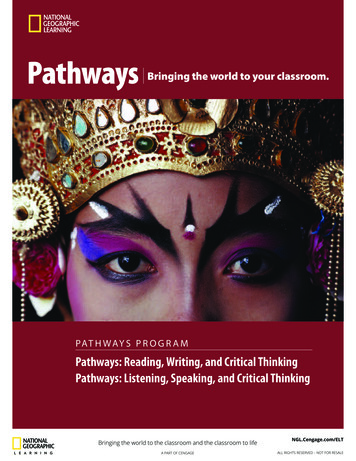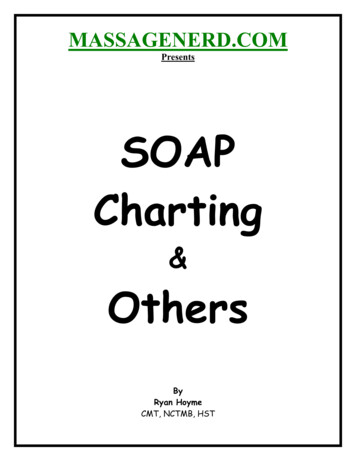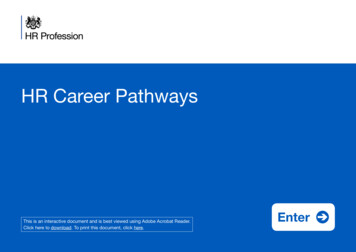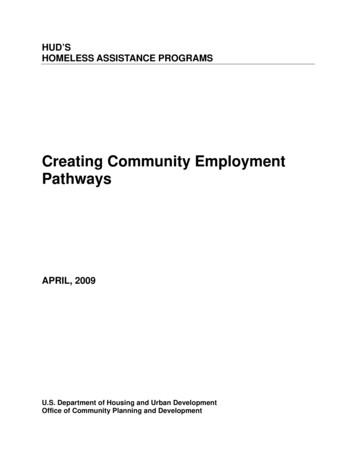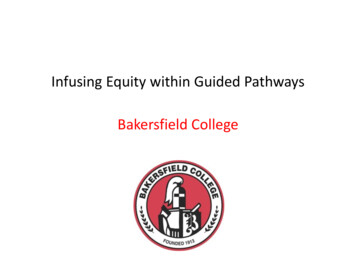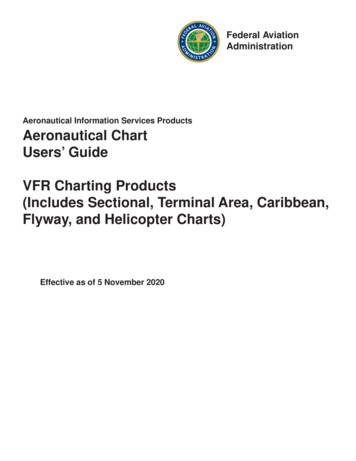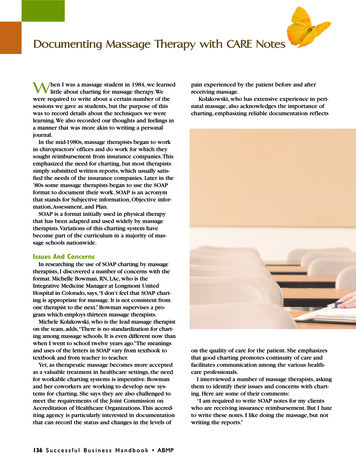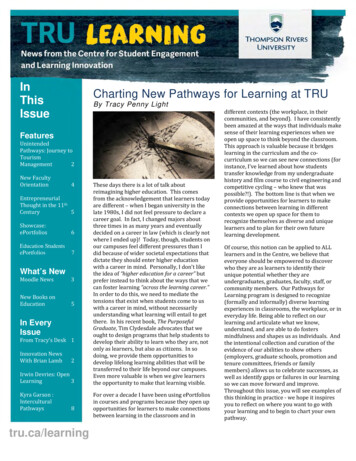
Transcription
InThisIssueCharting New Pathways for Learning at TRUBy Tracy Penny LightFeaturesUnintendedPathways: Journey toTourismManagement2New urialThought in the 11thCentury5Education StudentsePortfolios7What’s NewMoodle NewsNew Books onEducationIn EveryIssue35From Tracy’s Desk 1Innovation NewsWith Brian Lamb2Irwin Devries: OpenLearning3Kyra Garson :InterculturalPathways8tru.ca/learningThese days there is a lot of talk aboutreimagining higher education. This comesfrom the acknowledgement that learners todayare different – when I began university in thelate 1980s, I did not feel pressure to declare acareer goal. In fact, I changed majors aboutthree times in as many years and eventuallydecided on a career in law (which is clearly notwhere I ended up)! Today, though, students onour campuses feel different pressures than Idid because of wider societal expectations thatdictate they should enter higher educationwith a career in mind. Personally, I don’t likethe idea of “higher education for a career” butprefer instead to think about the ways that wecan foster learning “across the learning career.”In order to do this, we need to mediate thetensions that exist when students come to uswith a career in mind, without necessarilyunderstanding what learning will entail to getthere. In his recent book, The PurposefulGraduate, Tim Clydesdale advocates that weought to design programs that help students todevelop their ability to learn who they are, notonly as learners, but also as citizens. In sodoing, we provide them opportunities todevelop lifelong learning abilities that will betransferred to their life beyond our campuses.Even more valuable is when we give learnersthe opportunity to make that learning visible.For over a decade I have been using ePortfoliosin courses and programs because they open upopportunities for learners to make connectionsbetween learning in the classroom and indifferent contexts (the workplace, in theircommunities, and beyond). I have consistentlybeen amazed at the ways that individuals makesense of their learning experiences when weopen up space to think beyond the classroom.This approach is valuable because it bridgeslearning in the curriculum and the cocurriculum so we can see new connections (forinstance, I’ve learned about how studentstransfer knowledge from my undergraduatehistory and film course to civil engineering andcompetitive cycling – who knew that waspossible?!). The bottom line is that when weprovide opportunities for learners to makeconnections between learning in differentcontexts we open up space for them torecognize themselves as diverse and uniquelearners and to plan for their own futurelearning development.Of course, this notion can be applied to ALLlearners and in the Centre, we believe thateveryone should be empowered to discoverwho they are as learners to identify theirunique potential whether they areundergraduates, graduates, faculty, staff, orcommunity members. Our Pathways forLearning program is designed to recognize(formally and informally) diverse learningexperiences in classrooms, the workplace, or ineveryday life. Being able to reflect on ourlearning and articulate what we know,understand, and are able to do fostersmindfulness and shapes us as individuals. Andthe intentional collection and curation of theevidence of our abilities to show others(employers, graduate schools, promotion andtenure committees, friends or familymembers) allows us to celebrate successes, aswell as identify gaps or failures in our learningso we can move forward and improve.Throughout this issue, you will see examples ofthis thinking in practice - we hope it inspiresyou to reflect on where you want to go withyour learning and to begin to chart your ownpathway.age
Unintentended Pathways: Journey to Tourism ManagementBy Tracy Penny LightRobert Hood didn’t intend to pursuea career in Tourism Management –in fact, initially he planned tocontribute to the field of publicrecreation management havingspent most of his education focusedon recreation and leisure studies.But, as he recounts in a recentreflection on his career in aforthcoming book entitled, Traveland Tourism Management for theCurious: Why Study Travel andTourism Management?, careeropportunities allowed him totransition his interest in publicrecreation management to a focus ontourism. Rob’s shift in interests isnot uncommon. Many of us have hadunconventional career pathsfollowing our education and this willbe even more common for futuregraduates. Yet many of us do notshare our perspectives on educationor our disciplines, despite the valueof reflecting on our own beliefsabout teaching and learning andmaking that thinking visible. ForRob, this process allowed him toidentify that, “knowing,understanding and debatingphenomena from variousperspectives versus limitingknowledge and understanding toone specialization/discipline” washis own “personal preference” forlearning that has allowed him tomake contributions in theexploration of tourism in smallcommunities. This work, which oftenrequires understanding theperspectives of stakeholders “whowear many hats”, benefits from hisgeneralist perspective because heunderstands the perspectives of thecommunity constituents. His workover his career has reinforced forhim the importance ofmultidisciplinary education becausehe believes that this approach“enable[s] more effective humanaction for effectively addressingcomplex human problems.” Robadvocates developing programs thatallow for this kind of learning andcredits his path to tourismmanagement for making him awareof the value of building learningacross the disciplines.age2To read Rob’s full chapter, look for:Hood, R. (2015). “TourismManagement Education: A PersonalAccount”. In K. Vaidya (Ed.) Traveland Tourism Management for theCurious: Why Study Travel andTourism Management?Innovative Teaching Practices in MexicoBy Brian LambWhen I got back from Mexico, I didnot know how to respond to thequestion, “How was your holiday?”That was because I was coming backfrom two of the most intense andhard-working weeks of my life. I waspart of a project hosted at theUniversity of Guadalajara (UdG), inpartnership with the Justice Instituteof British Columbia. The challengewas to work with more than 300UdG instructors (two one-weekcohorts of 150 each) who had justbeen issued new iPads in thepractice of active, participatorylearning using mobile, networkedtechnologies.The week was primarily composedof “studios”. Each participant tookpart in “foundational studios” onsubjects like student-centred coursedesign and collaborative learning.They then chose from a set of studiosDSFGALDSKJGFALRGon skills such as audio and videoproduction, alternative assessments,and open educational resources. Ifulfilled a long-held dream when Iput together a studio on using andcreating animated GIFs. What wasnotable about these studios was thefocus on hands-on practice. We keptthe lecturing to no more than tenminutes per studio, directingparticipants to a series of“challenges” ranging from very easyto quite advanced. It was gratifyingto see how doggedly and creativelyour participants tackled thesechallenges.We managed the activities in aWordPress-based open environmentthat you can check out at:http://udg.theagoraonline.net/. Wejust moved on to the “virtual” phase,where participants apply what theylearned in their courses, with onlinecoaching. I’m thrilled to be returningBrian Lamb, onsite in Mexico.Summer 2015to Guadalajara to see how it all turns outand look forward to using what I learnedhere at TRU.Brian Lamb is the Director of Innovation,Open Learning and is a regular columnistfor TRU Learning.2
Supporting Success Through Open TextbooksBy Irwin DevriesageFor several years Open Learning has been involved indeveloping online courses based on open textbooks.Currently these textbooks are in the areas of psychology,geology, history and sociology. The open textbookdevelopment is connected to the provincial BCCampusOpen Textbook project, funded by the BC Ministry ofAdvanced Education.In a presentation at TRU earlier this spring, Clint Lalondeof BCCampus explained that 65% of students surveyedhave avoided purchasing textbooks due to theirunaffordability, and 35% have reduced their course loadto avoid textbook purchases. Further, because of rapidversion updates and increasing use of digital textbooksthat disappear after a certain period of time, the timehonoured option of selling and buying used textbooks isincreasingly under attack. The purpose of open textbookinitiatives in BC, across North America and around theworld, is to address these problems and ensure studentsare able to access the textbooks they need to undertaketheir education.3As defined by Lalonde, open textbooks are “licensed underan open copyright license, and made available online to befreely used by students, teachers and members of thepublic. They are available for free as online versions, andas low-cost printed versions, should students opt forthese.” In addition, faculty are free to adapt, revise, remix,supplement and otherwise customize open textbooks,which are available in both ready-to-distribute andeditable formats. All open textbooks are faculty-writtenand peer reviewed to ensure quality.In addition to building online courses based on opentextbooks, Open Learning has begun to work withBCCampus to edit and produce an open textbook, with theintent of growing our expertise in, as well as supportingand sustaining, this important student-centred movementin open education into the future.Irwin Devries is the Director of Curriculum Development,Open Learning, at TRU and is a regular columnist for TRULearningMoodle NewsBy Tracy Penny LightAs you may be aware, our colleague and friend DougBaleshta retired on August 31, 2015. Doug tirelesslyprovided support to faculty, staff and students on theirusage of our Learning Management System (LMS),Moodle. Thank you, Doug, and all the best!Over the summer, a team-based collaborative approach tosupporting Moodle was developed. Moodle users can nowaccess the support team, which includes members fromthe Centre, IT Services and Open Learning, by emailingmoodlesupport@tru.ca. Answers to questions will beprovided by the team within 48 hours during businesshours (Monday-Friday, 8:00am-4:30pm).In addition to the support line, the Centre is offeringMoodle drop-in sessions for hands-on support, as well asworkshops on Moodle topics, such as designing effectivelearning activities and the gradebook. Information on theworkshops and registration can be found on our websitetru.ca/learning.We are also working to develop a Learning ResourcesRepository, which will allow instructors to import andadapt learning activities for their own courses. Weultimately plan to make the LMS (Learning ManagementSystem) easier to use. If you have suggestions or requests,we would love to hear from you!3
New Faculty Orientation 2015By Denise KingThe Centre for Student Engagement and Learning Innovationand the Provost office co-hosted the 2015 New FacultyOrientation. All new tenure track and limited term faculty wereinvited to the orientation.ageThe orientation opened with an acknowledgement andrecognition of the traditional Secwepemc Territory by PaulMichel and welcoming remarks from Alan Shaver.The first day of workshops included: understanding TRU context and culture,designing learning outcomesgroup workfeedback sessions4The second day focused on: learning outcomescourse outline developmenthands-on Moodle trainingcopyright and the library resources presentationsThe new Provost, Christine Bovis-Cnossen, joined the group forlunch along with Tom Dickinson, Sandra Vermeulen, MichaelHenry, Donna Murnaghan, and James Gaisford. The eventwrapped up with a social at the Monte Creek Winery.New Faculty Orientation will be offered each August and plansare underway to develop something similar for SessionalInstructors.“[I] Really enjoyed sharingwith other new faculty.Great to meet President andadministrators.”Paricipants from left to right: Jim Gaisford, Tom Dickinson,Tracy Penny Light, Christine Bovis-Cnossen, SandraVermeulen, Noeman Mirza, Jenni Karl, Tanya Sanders, SheilaBlackstock, Silvia Straka, Ted Howe, Kyra Garson, Joel Wood,Gary Hunt, Brenda Smith, Ehsan Ahmed, Xiaoping Shi“[I] Absolutely loved thepacing of the content . . .Also liked how attendeeswere from differentfaculties. The facilitatorwas very knowledgeableand helpful.”4
New Books on Higher Education:What We’re ReadingBy Tracy Penny LightWe are always looking at the literature in higher education to inform ourthinking about learning and our programming in the Centre. Here are somerecent finds that we think you might find interesting too:ageTim Clydesdale, The Purposeful Graduate: Why Colleges Must Talk to Studentsabout Vocation (Chicago: University of Chicago Press, 2015). Clydesdaleargues that in a time when most students pursue higher education in searchof a career, rather than to explore “the big questions about who they are andhow they can change the world,” we need to ensure that we develop creativeprograms that allow our undergraduates to explore the question of purpose.This is a central tenet of our Pathways for Learning program. To learn more,go to ne Hoffman Beyer, Edward Taylor and Gerald M. Gillmore, Inside theUndergraduate Teaching Experience: The University of Washington’s Growth inFaculty Teaching Study (New York: State University of New York Press, 2013).Beyer, Taylor and Gillmore share their qualitative study of faculty members atthe University of Washington. The findings point to the ways that faculty arecontinually working to improve their practice and how they have increasinglymoved toward a student-centred approach to teaching.We agree with the notion the authors put forth that teaching should be apublic activity; the work we all put into our teaching should be shared withour colleagues.As Joseph Katz and Mildred Henry so aptly noted, “Teaching is a lifelong artthat involves continuous learning not just for the student but for the teacheras well.” This research makes that visible, and aligns well with what we knowis happening at TRU. The Centre is actively working to make the work of ourfaculty more visible!Pathways to Interdisciplinarity: Entrepreneurial Thought inthe 11th CenturyBy Brianna McIlquhamAnnie St John-Stark wanted to find a way to implementhands-on collaborative learning in her History 3520Course: Knowledge and Belief in Medieval to EarlyModern Europe, offered in the winter semester of 2015.In a subject that is traditionally approached with adiscussion based instructional method, St. John-Stark’s16 students completed a hands-on group project whereinthey were given a common issue of the time period, andhad to design an instrument to solve the problem usingonly materials that existed in that time period.St. John-Stark gave her students two different issues tosolve: to diagnose the cause of stomach pain in a 25 yearold male; and to remove leaf and dirt matter from abasket of wheat. “I was trying to get them to think notlike 2015 people, think only with what they would havehad had they been alive in the 11th, 12th, 13thcenturies,” St. John-Stark said. The innovative projectwas very well received by her students, “They loved it!They totally did! They were very excited about it,” St.John-Stark said.A device for sorting leaf and dirt matter from wheat,designed by the HIST 3520 studentsSt. John-Stark hopes this type of hands-on assignment willeventually serve as a bridge between Arts and the Tradesand Technology department at TRU. History 3520 will beoffered again in winter 2016 if enough interest is shown bystudents for the course, otherwise it will be offered againin winter 2017. If you’re interested in taking History 3520or are looking for innovative ideas to use in the classroom,contact us at learning@tru.ca5
Showcase: ePortfoliosBy Brianna McIlquhamThe Centre for Student Engagement andLearning Innovation (CSELI) is excited to bethe feature subject of an article that focuseson the integration of ePortfolios into studentlearning at TRU that was recently publishedin Excellence in Education: 2015 BC Edition.The article, which was written by Marketingand Communications at TRU, explains howthe CSELI uses ePortfolios as a tool thatsupports learners to clearly articulate howtheir unique and diverse learningexperiences connects or transfers to othercontexts.The article highlights a number of studentsand faculty members who are integratingePortfolios into their teaching and learningpractices at TRU. Students have developedePortfolios in order to articulate theirlearning for certificates such as GlobalCompetency or Leadership inEnvironmental Sustainability, as well as toshowcase teaching practices, or to reflectand provide evidence of learning acrossmultiple pathways. Faculty members arealso beginning to weave ePortfolios intotheir classroom activities, with studentsbeing given the opportunity to submitassignments in the form of an ePortfolio.age6Hailee-Jean’s ePortfolio is a showcase of her learning through diverseexperiences, such as her photography hobby.If you’re interested in developing anePortfolio, please visit our webpagetru.ca/learning for more information.To read the full article in “Excellence inEducation” please visit www.issuu.com andsearch “Excellence in Education”.Simone’s ePortfolio shows evidence of her learning through experiences,such as Study Abroad for the Global Competency Certificate.Katherine Ancheta developed her ePortfolioduring her co-op work term at the TRUWellness Centre, while also volunteering withthe Centre for Student Engagement andLearning Innovation. Her ePortfolio leveragesthe many facets of her life, including herinvolvement in various on-campus clubs, herco-op work term, and her role as a motherwith her education focus of Human ResourceManagement. Katherine utilizes manyinnovative techniques in her ePortfolio suchas inclusion of her Twitter feed, and a pagedevoted to ongoing blog posts. Great workKatherine!6
Sustainable ePortfolio Development for Education StudentsBy Cameron Staffage7Megan Harstad’s and Ashley Nordin’s ePortfolio’s - developed for theBachelor of Education Program.Edward Howe, a professor in the Faculty of Human,Social and Educational Development, spent the summerworking closely with two Bachelor of Education (BEd)students to pilot the use of ePortfolios in the BEdprogram for the upcoming academic year. “I am excitedabout piloting the use of ePortfolios with incoming TCs(Teacher Candidates) this fall,” said Howe. “TheePortfolio is helping students make connections betweentheir education and experiences in other courses whilehelping faculty effectively work on course articulationand program review.”Electronic Portfolios show great potential for TCs in anumber of ways. “In making an ePortfolio, TCs mustcritically reflect on their learning and provide evidenceto demonstrate teaching competencies,” explained Howe.“This is an excellent way to re-confirm why they havechosen to become a teacher.”The ePortfolio project is something the faculty membersthought would be an excellent addition to the program.First introduced to the concept a few years ago at anational education conference, Howe was eager to be apart of piloting the project over the summer. “I decidedto take a leadership role in this exciting project because Ihave seen how effective ePortfolios can be,” said Howe. “Iwas impressed at the potential of ePortfolios to highlightthe curriculum, teaching and learning of novice teacherswhile providing an effective tool for reflexive pedagogies.”Ashley Nordin and Megan Harstad, both second year BEdstudents, worked with Howe throughout the summer andwill help provide an ePortfolio workshop for the first yearTCs.“I feel as though this project reminded me of how much Ilearned during my first year of the Bachelor of Educationprogram,” said Nordin.The implementation of ePortfolios into any programallows students to integrate what they learn across all oftheir courses. “A major part of my portfolio wassummarizing all that I have learned so far at TRU,” saidHarstad. “In our Teaching and Learning class we are taughtdifferent ways of teaching, assessing and classroommanagement skills,” added Nordin. “By having some of myassignments in my ePortfolio it clearly demonstrates who Iam as a student teacher.”Though the project is brand new, Howe is confident thatthe implementation of ePortfolios will have a positiveeffect on the BEd program, “We are just starting thisproject. There is much further work to do,” said Howe.“But, as we go through a program review, it is a good timeto be embarking on such a venture And what a great timeto be a teacher educator!”Course EvaluationsTRU is committed to providing students the opportunity to provide feedback on theirexperience of learning in their courses. The CSELI provides support for TRU in movingtoward a continuous improvement model of teaching.Learn more: tru.ca/learning7
Intercultural Pathways with Kyra GarsonBy Kyra Garsonfaculty members are working to providestudents with classroom exposure to thecognitive, affective, and behavioral aspects ofintercultural learning.TRU has identified Increasing InterculturalUnderstanding as one of its five StrategicPriorities. Although there are numerous waysin which students may gain interculturalunderstanding, from their personalexperiences to exchanges on social media,TRU’s commitment to this goal requiresintentional curricular and pedagogicalplanning to ensure students’ experiences leadto positive development and does notinadvertently result in entrenched stereotypesand biases.In May 2015, the fifth cohort of facultyparticipated in the Interculturalizing theCurriculum Program, bringing the number ofinterdisciplinary participants to 75.Participants explore intercultural theory,pedagogical approaches, and curricularinnovations in order to apply relevantframeworks to their own teaching practice andenhance disciplinary learning outcomes. TheseAs students begin to chart their educationaljourneys through the new Pathways program,they will no doubt appreciate the efforts ofeducators providing opportunities to meetpathways outcomes through coursework. Insome disciplines, course content may moreeasily lend itself to intercultural learning;however, working with faculty who teachcourses such as Canadian Tax, Microbiology,Dendrology, and the History of VictorianEngland has reinforced that interculturallearning can be infused into learning across thedisciplines and result in TRU graduatesfulfilling the disciplinary learning central totheir degree while at the same time developingintercultural understanding that willcontribute to their effective participation inour increasingly multicultural andinterconnected contexts.In subsequent issues of this newsletter, theCentre will feature faculty members whoseinnovative approaches include interculturallearning in course work, setting students up toarticulate their own pathways to learningduring their university experience and beyond.Kyra Garson is the Intercultural Coordinator atthe CSELI and is a regular columnist for TRULearningGlobal CompetencyTRU Global Competency allows students toearn formal recognition for their interculturaland international experiences – from StudyAbroad, to learning a second language, tovolunteer work.Contact lesupport@tru.caTo subscribe to the onlineversion of this newsletterplease visit our website.TRU LearningAuthors: VariousEditor: BriannaMcIlquhambmcilquham@tru.caThompson RiversUniversityCentre for StudentEngagement andLearning InnovationOM 1468TRU Learning is publishedthree times per year bythe Centre for StudentEngagement and LearningInnovation.Want to learn more about this?Phone: 250.371.5996Drop in at: OM 1468Visit our webpage: tru.ca/global8age8
From Tracy's Desk 1. Innovation News With Brian Lamb 2. Irwin Devries: Open Learning 3 . Kyra Garson : Intercultural Pathways 8 Charting New Pathways for Learning at TRU By Tracy Penny Light . different contexts (the workplace, in their communities, and beyond). I have consistently been amazed at the ways that individuals make
